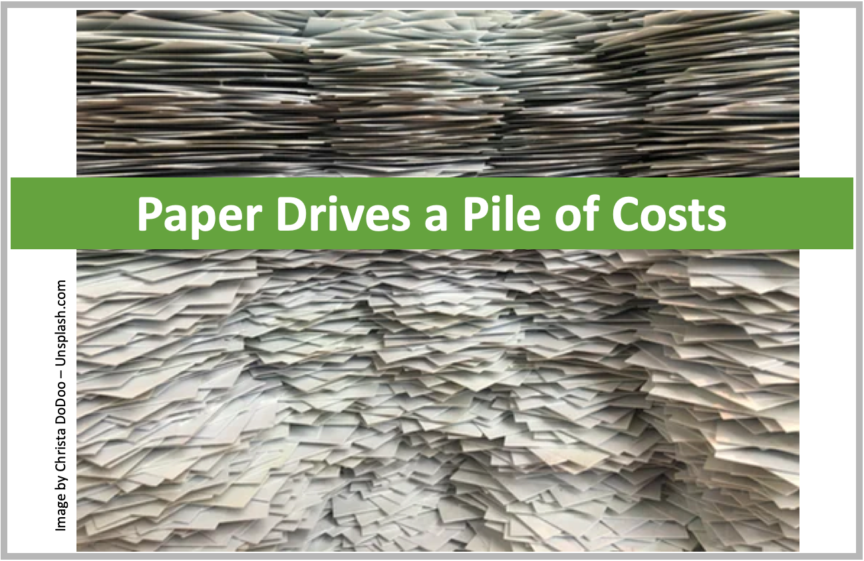Inkjet technologies have enabled in-plants and service providers to print more, faster, and at a lower cost. The big buckets for cost considerations when migrating to inkjet include assessing the capital requirements, changes in operating costs for inks and service plans, power consumption, and changes in labor and finishing. Many have found significant savings in TOC with inkjet. However, paper is still the largest variable cost for any print job. Choosing wisely with inkjet is critical not only from a cost perspective, because paper becomes the fifth color when printing inkjet. The final image quality, the speed of production, and the speed of finishing will all be impacted by the paper choice.
Choose the best paper for the job
Choosing the right paper for your inkjet technology and client applications is a critical success factor with inkjet. In-plants evolving from offset to inkjet are primarily running commercial grade offset stocks that are either coated or uncoated. Operations running primarily digital print toner devices are running digital grade papers. Each of these papers will perform differently with inkjet, as the inks have a significantly higher proportion of water in which the pigments or dyes are suspended. The inks are being jetted at faster speeds, creating a more complex interaction of water, ink, paper and heat (for drying). How the ink interacts with the paper, depending on smoothness and types of coating or treatments, will determine how much ink is absorbed into the paper fibers and how much ink stays on top of the sheet before drying. The interaction of paper, ink and drying will impact the image quality in terms of vibrancy of color, color rendition, sharpness, contrast, etc.
When to spend more on paper
Offset stocks – both uncoated and coated – are less expensive than inkjet treated and inkjet coated papers. While many in-plants have often pursued the lowest cost paper options for their offset or digital printers, this strategy will have significant ramifications beyond the cost of paper in inkjet production.
Less expensive offset stocks, and lower grade papers, have more dust than inkjet treated and inkjet coated stocks. The OEMs have worked extensively with all the major paper mills to develop specific papers that will run optimally on inkjet presses. While dust is a factor in toner or offset print environments, dust is the enemy in inkjet environments. Dust causes head clogging, jet outs, and additional maintenance cycles to purge ink. Additionally, excessive dust contributes to downtime. The amount of paper dust becomes a significant cost factor when evaluating operational running cost.
We have seen first-hand that lower quality papers also contribute to web breakage and downtime in the finishing process. Highspeed inkjet equipment is designed for speed. Many printers run with a tight web configuration, adding pressure to the paper as it moves through the equipment. Differing amounts of heat are applied to the paper in the drying process – depending on area coverage and paper type. While there is incremental cost for inkjet treated and coated stocks, the increased cost of paper may be relatively small when compared to the complex cost of downtime, additional maintenance, and running at a slower speed to avoid breakage. As well as the potential costs for rerunning jobs due to jet outs or poor image quality.
Smart paper costing and buying requires both art and science, plus an ongoing financial analysis as prices fluctuate with market conditions. Each OEM has an ink estimation tool to assist in determining ink usage by job. OEMs will run multiple sets of samples on different stocks at different speeds to present options from an image quality, throughput and cost perspective. The paper choice will also impact how much ink is used. Uncoated stocks will absorb more ink than treated/coated stocks. More ink may be needed based on area coverage to produce an acceptable image quality.
Paper impacts other costs
As in-plants move to inkjet, they need to change their pricing philosophy about papers. The cost of paper is no longer a line item on the cost estimate. The cost of a specific paper whether, uncoated, treated or coated, will impact the ink used and may impact the speed the job can run to produce the desired image quality.
Paper pricing is complex due to volume, suppliers, relationships, contracts and supply and demand. The incremental costs for inkjet treated, or coated stocks can vary widely between 2% – 35% more than offset, uncoated and digital stocks. Paper buying is situational – based on who is buying what, from whom and when.
While ink is the largest difference in operating cost for inkjet compared to offset and toner devices, the importance of testing different stocks and completing detailed cost analysis for different paper options is a critical success factor in inkjet production.
Are you getting the paper information you need to evaluate paper? See what other Inkjet Readers said in Inkjet Insight’s latest research report.

